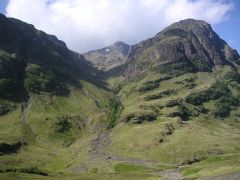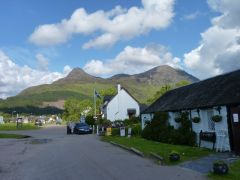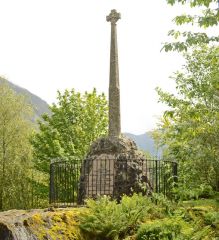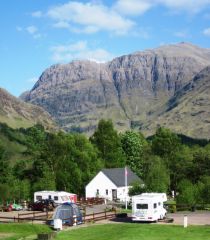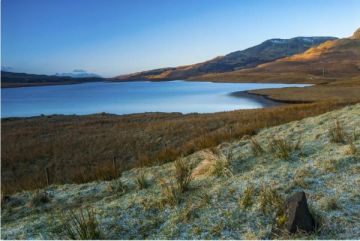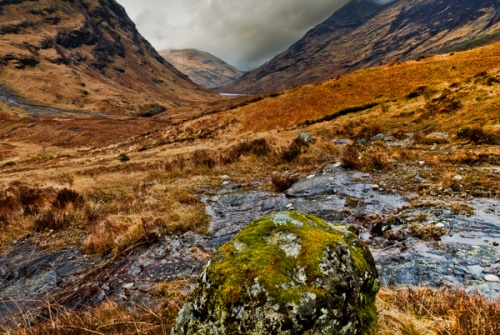
Glencoe offers over 4,000 acres (5665.5ha) of magnificent Highland landscape bisected with climbing and walking trails. The dramatic and beautiful mountain area was the site of the 1692 massacre of the MacDonalds by the Campbells.
There is walking information in the Visitor Centre (guided walks available). A well-marked footpath ascends Buachaille Etive Beag, one of Scotland's most popular mountains for climbers.
Mythology
Fingal, the legendary Celtic hero of myth and legend was said to live in Glencoe. Fingal was the leader of the Feinn, a band of heroic warriors. Though Fingal may not be a real person, the name lives on in several place names around the glen, such as Dun-Fionn, 'the hill of Fingal' on the north, or Sgor nam Fiannaidh (rock of the Feinn). Finn's son was Ossian, or Oisin, sometimes known as Fionn mac Cumhail, which was later anglicised as Finn McCool. The name 'coe' may refer to the river Cona, where Ossian was said to have been born.
Fingal was said to have defeated the Viking leader Erragon of Sora, but the Viking influence could not be held at bay for long. The descendants of Erregon became the MacDougall clan, and the MacDougalls held control over Glencoe from the 11th century.
The clan built a strong base of power in western Scotland, but in 1308 they 'backed the wrong horse', or in this case, the wrong contender for the Scottish throne. The clan threw in their lot with the Balliol family against Robert Bruce. After Bruce gained the throne he awarded Glencoe to Angus Og, chief of the MacDonald clan.
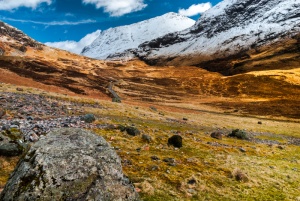
The MacDonalds held the glen until 1501 when conflict broke out between the MacDonalds and the Campbells of Argyll. There was fault on both sides; the MacDonalds stole Campbell cattle, and the Campbells kept trying to annex MacDonald territory. The conflict carried on into the 17th century, when the clans found themselves on opposite sides of the Wars of the Covenant.
The Campbells supported the government, while the MacDonalds allied with the Royalist cause. To put it in simple terms, the MacDonalds represented the traditional Highland way of life, while the Campbells represented Scottish ties to England and government control. The centuries-long conflict came to head in one of the most infamous episodes in Scottish history.
The Glencoe Massacre
On 27 August 1691 William III offered a pardon to all Highland clans who had raided their neighbouring clans or fought against the crown. It was a pardon with a very important condition; clan leaders had to take an oath of allegiance by 1 January 1692 or face a penalty of death.
A Fatal Mistake
The chief of Clan MacDonald was MacIain of Glencoe. He did not want to take the oath of allegiance but felt he had no choice. However, he made a fatal mistake; he went to Inverlochy, outside Fort William, to take the oath, when he should have gone to Inveraray. When he arrived in Inverlochy to find the royal representative gone, he left for Inveraray but did not arrive until 6 January. He took the oath and returned to Glencoe, thinking he had assured the safety of his clan.
In a sequence of events that even now is open to interpretation, the government assembled a force of 130 men with orders to exterminate the entire MacDonald clan. As fortune would have it the government force was commanded by Captain Robert Campbell of Glen Lyon. Campbell marched his men to Glencoe and asked the MacDonalds for quarter.
The MacDonalds opened their home to the government troops, and for 10 days they entertained them. On 12 February orders reached Captain Campbell to kill every MacDonald under the age of 70. In the early hours of the next morning the Campbell troops rose stealthily from their beds and slew their hosts.
Forty MacDonalds were slain in the initial attack, and the rest escaped into the bitter winter snow, only to die of exposure amid the Glencoe hills.
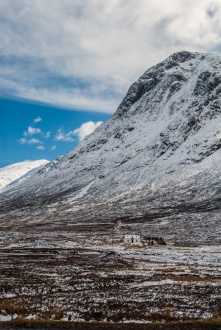
beneath a snowy peak
The massacre was not the largest loss of life in the long and bloody history of clan warfare, far from it. But it was the nature of the attack that still stirs feelings; turning unexpectedly on those who had opened their homes to old enemies and treated them as friends.
A monument to those who died in the attack stands in Glencoe village. Maclain was buried on the island of Eilean Munde, in Loch Leven. Signal Rock, near the Clachaig Inn, marks the spot where the order to begin the Massacre was given.
The first road through the glen itself was built in 1785 as part of government attempts to control the Highland clans. Population declined over the next century as the Highland Clearances forced people out in favour of sheep.
In 1935 the National Trust for Scotland bought over 12,000 acres of the glen to protect it from commercial exploitation. The Trust's holdings were extended gradually over the following decades until today it owns much of the glen and the surrounding area.
Visiting
Glencoe village lies at the western edge of the glen, and a mile further west is Ballachulish. Both settlements have facilities for visitors and accommodation options. There is an official visitor centre at the western end of the glen, with information on footpaths and local outdoor activities.
There are 3 official campsites in the glen, and wild camping is allowed in some areas. Perhaps the most popular place to stay (at least for determined climbers) is the Clachaig Inn and its nearby campground, about 3 miles from Glencoe village. Between the inn and the village is a hostel run by the Scottish Youth Hostel Association. About 1 mile from the eastern head of the glen is the Kings House Hotel, a historic coaching inn.
The development of the West Highland Way long-distance trail has led to a large increase in the number of walkers in recent years. The trail follows the route of the old military road over Rannoch Moor and descends the glen along the Devil's Staircase down the glen.
On the east side of the glen is the Glencoe ski area, sometimes called White Corries.
About Glen Coe
Address: NTS Glencoe Visitor Centre,
Glencoe,
Lochaber,
Highlands,
Highland,
Scotland, PH49 4HX
Attraction Type: Countryside
Location: On the A82, south of Fort William
Website: Glen Coe
Email: glencoe@nts.org.uk
National Trust for Scotland
Location
map
OS: NN118 566
Photo Credit: David Ross and Britain Express
HERITAGE
 We've 'tagged' this attraction information to help you find related historic attractions and learn more about major time periods mentioned.
We've 'tagged' this attraction information to help you find related historic attractions and learn more about major time periods mentioned.
Find other attractions tagged with:
11th century (Time Period) - 17th century (Time Period) - Celtic (Architecture) - Royalist (Person) - Viking (Historical Reference) -
NEARBY HISTORIC ATTRACTIONS
Heritage Rated from 1- 5 (low to exceptional) on historic interest
West Highland Museum - 10.7 miles (Museum) ![]()
Road to the Isles - 10.8 miles (Countryside) ![]()
Old Inverlochy Castle - 11.7 miles (Castle) ![]()
Neptune's Staircase - 12.5 miles (Landmark) ![]()
Castle Stalker - 13.8 miles (Castle) ![]()
Ardchattan Priory - 16.3 miles (Abbey) ![]()
Bonawe Iron Furnace - 16.9 miles (Historic Building) ![]()
Kilchurn Castle - 18.1 miles (Castle) ![]()
Nearest Holiday Cottages to Glen Coe:
Nearby accommodation is calculated 'as the crow flies' from Glen Coe. 'Nearest' may involve a long drive up and down glens or, if you are near the coast, may include a ferry ride! Please check the property map to make sure the location is right for you.
Glencoe, Highlands and Islands
Sleeps: 10
Stay from: £2030 - 7639
Ballachulish, Highlands and Islands
Sleeps: 6
Stay from: £521 - 2326
Ballachulish, Highlands and Islands
Sleeps: 4
Stay from: £517 - 3020
More self catering near Glen Coe
